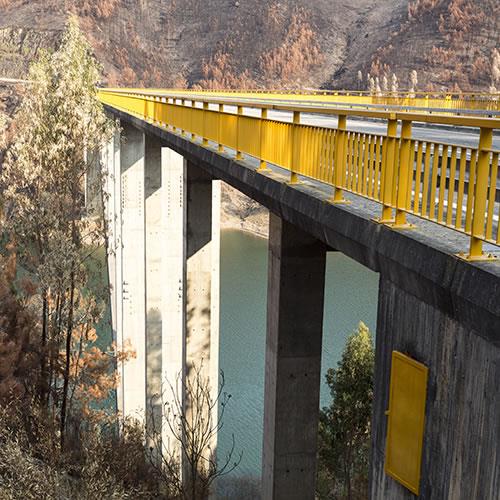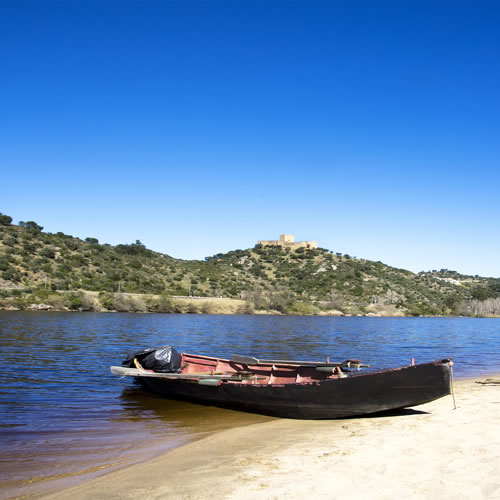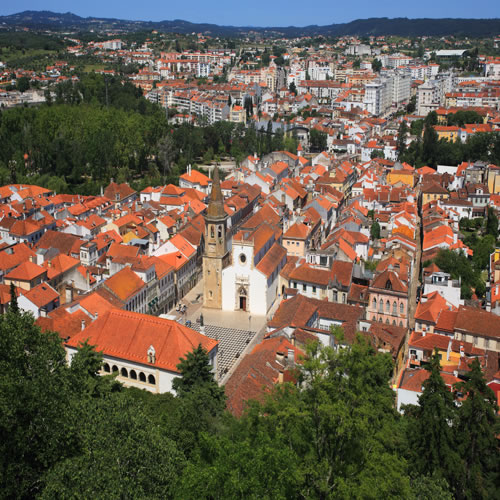RIBATEJO - TOWNS AND VILLAGES

Abrantes
The city of Abrantes (pop. 17,000) is situated on the Tagus River, approximately 38 miles northeast of Santarem, which is also located on the Tagus. Abrantes was originally settled by the Celts in the third century before the Common Era. The next group to live in the area, the Romans, named the area `Aurantes`, due to the gold deposits found nearby in the Tagus River. The Moors built a castle to protect the settlement in the eighth century, on a hillside where a Lusitanian castro once stood. When the Portuguese took the land back from the Moors, Abrantes Castle became one of the foremost defenses on the Tagus Line, which protected the countryside from invasions by the Castilians. The castle protected the town for centuries, until 1807, when Napoleon`s forces looted the city and took up residence inside the castle walls. In August 1808, the town was returned to the Portuguese.
Points of interest in Abrantes include the aforementioned Abrantes Castle; the Aldeia do Mato riverside beach; the Aquapolis public park, with a land and river component for visitors to enjoy picnics and kayaking; and the churches Igreja de Sao Vicente and the Igreja de Sao Joao Baptista. While you`re in the area, try some delicious Abrantes-centric desserts, such as `tigelada` (a custard similar to creme brulee) and sweet egg yolk threads called `palha de Abrantes` (lit. `Abrantes straw`).

Ferreira do Zezere
The small town of Ferreira do Zezere (pop. 2,353) sits in a valley between a forest and the lagoon formed by the Castelo de Bode Dam, which feeds directly into the Zezere River about 13 miles south of the town. For reference, Ferreira do Zezere is located nine miles northeast of Tomar. The town is well-known for its water sports and lagoon beaches, with the closest beach sitting just across the lagoon from the town and the Capela de Sao Pedro do Castro. As the name suggests, the hillside chapel, only accessible via a walking trail, was built on the site of a former Roman castro. Another noteworthy Roman-era historic building is the Torre de Dornes, which was given to the Knights Templar during the time of the Reconquista. Ferreira do Zezere is perhaps best-known, however, for its gastronomic tradition. Try a few dishes that are native to the area, such as `cabrito com grelos` (baby goat with broccoli rabe), stuffed tripe, and piglet `Ferreirense` (roasted and garnished with oranges and olives).


Ourem
Ourem (pop. 12,000) is located approximately eleven miles from Tomar and only six miles from the town of Fatima. The towns of Ourem and Fatima have been linked for centuries; the Moorish princess Fatima, as the story was told, converted to Christianity and took the name Oureana. In her honor, the town (which was once called Abdegas) was renamed Ourem. Once conquered by the Portuguese in the twelfth century CE, the King of Portugal gave the town of Ourem to his daughter, Dona Teresa, as a gift: she commissioned the construction of a castle to protect the nearby lands. By the end of the twelfth century, Ourem Castle was complete. It sits approximately a mile and a half southwest of the current town (sometimes referred to as Vila Nova de Ourem). The historic center of Old Ourem, around the castle, also includes the former mansion of the House of Braganca, and the Igreja da Colegiada, the mother church of the town of Ourem. Those buildings were completed by the end of the 15th century. In addition to the sights already mentioned, Ourem is a great jumping-off point for exploring the Grutas da Moeda caves, the Roman-era Pegoes Aqueduct, and the Catholic pilgrimage site of Fatima.


Santarem
A little less than 50 miles northeast of Lisbon, on the Tagus River, sits the city of Santarem (pop. 30,000). The Lusitanians were the first to settle the area, in the time before the Common Era. The Visigoths named the settlement `Sancta Irene`, after the saint who was martyred in Tomar; in Portuguese it was eventually corrupted to `Santarem`. During the time of the Romans it was known as `Scalabis`, and was built in such a manner that it became one of the more important settlements in the Roman province of Lusitania. Santarem thrived as a Portuguese town from the very first dynasty; it was the capital of the Kingdom from 1325 to 1357, and it was also the earliest meeting place of the king`s court (the `Cortes`). Pedro Alvares Cabral, who discovered Brazil and claimed it for Portugal in the year 1500, lived in Santarem for a large portion of his life.
Santarem is well-known for its yearly festivals, such as the National Agricultural Fair which brings tens of thousands of people from all over the country and Europe together to present their products and innovations. There is also a cattle market and a bullfight held during this time; if you want to see an authentic Portuguese bullfight, this is the best time of year to visit Santarem. Santarem is also well-known for the delicious delights that can be tasted and savored at the National Gastronomy Festival, held in October or November depending on the year. This is a great time for foodies and also for dance enthusiasts, who can watch Santarem`s time-honored traditional dance, the fandango.
Architecture lovers will be enthralled with Santarem as it offers many of points of interest with architectural marvels dating from a number of time periods. For example, there is the Mannerist and Baroque Se Catedral; the Renaissance and Manueline Igreja de Marvila; the flamboyantly Gothic Igreja da Graca; and similarly dramatic Gothic religious buildings such as the Church of St. Stephen, the Convento de Sao Francisco; and the Convento de Santa Clara. Other points of interest include the Igreja de Sao Joao de Alporao, which doubles as the town`s archaeological museum; and the Porta do Sol, the old castle of Santarem, whose ruins are perched on a high hill above the Tagus.


Tomar
The last city in Portugal to be constructed by the Order of the Knights Templar, Tomar (pop. 20,000) is seen today as the quintessential Templar showcase, nine centuries after it was built. Tomar was originally built inside the walls of the Templar`s headquarters in Portugal, the UNESCO World Heritage-certified Convento de Cristo. From there, the town grew to reach the nearby Nabao River, a tributary of the Tagus, and eventually expanded to the eastern bank as well. Tomar`s Old Town is located on the west side of the Nabao, and is bounded to the west by the Convento de Cristo and the Mata Nacional dos Sete Montes park. Points of interest include the aforementioned Convento de Cristo; the Igreja de Sao Joao Baptista; the mini-Jewish Quarter on Rua Doutor Joaquim Jacinto, which includes the dual synagogue and Portuguese Jewish history museum named for Abraham Zacuto; and the Palacio de Alvaiazere. About thirty minutes south of Tomar, located on an islet on the Tagus River, is Almourol Castle, built around the same time as the Convento de Cristo (the late 12th century), also by the Knights Templar.